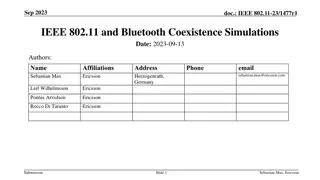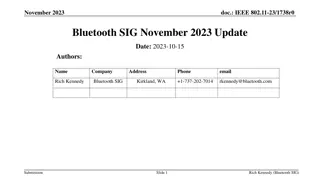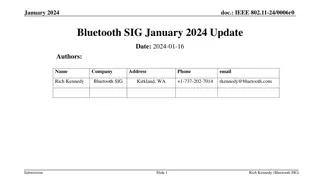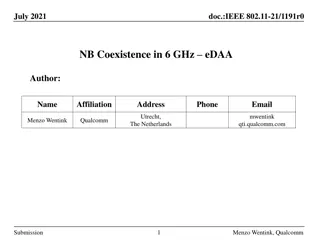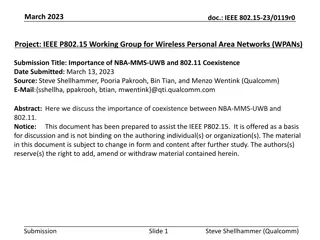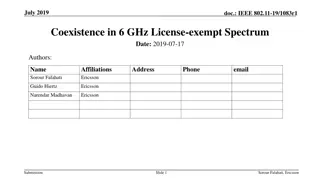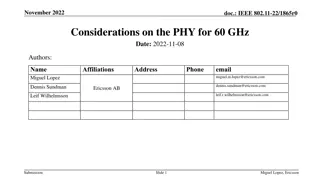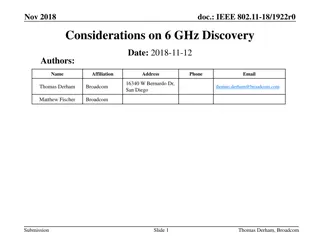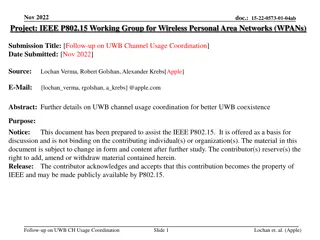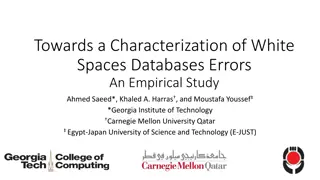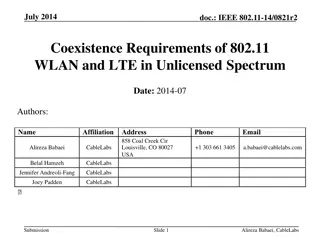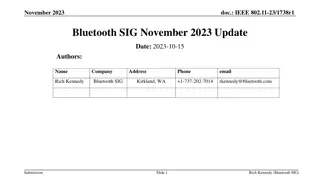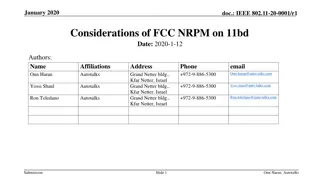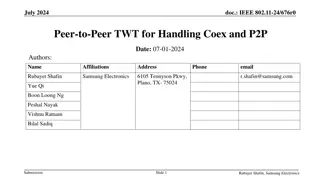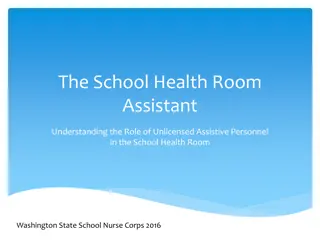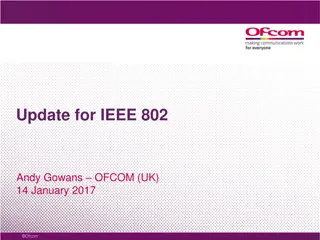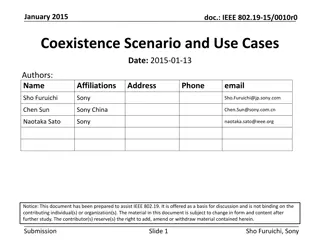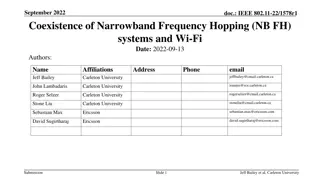Key Coexistence Issues in 5-7 GHz Unlicensed Spectrum for NR Sidelink Evolution
3GPP RAN1 is extending NR sidelink operation to 5-7 GHz unlicensed spectrum, raising concerns about channel access and physical design. Discussions include Listen Before Talk protocols, UE-to-UE COT sharing, and coexistence with WiFi technologies. The study aims to specify support for sidelink on unlicensed spectrum in both mode 1 and mode 2, focusing on FR1 bands. Regulatory requirements in the USA and EU for 5 and 6 GHz unlicensed bands are also outlined.
Download Presentation

Please find below an Image/Link to download the presentation.
The content on the website is provided AS IS for your information and personal use only. It may not be sold, licensed, or shared on other websites without obtaining consent from the author.If you encounter any issues during the download, it is possible that the publisher has removed the file from their server.
You are allowed to download the files provided on this website for personal or commercial use, subject to the condition that they are used lawfully. All files are the property of their respective owners.
The content on the website is provided AS IS for your information and personal use only. It may not be sold, licensed, or shared on other websites without obtaining consent from the author.
E N D
Presentation Transcript
January 2023 doc.: IEEE 802.11-23/0052r1 Notes from 3GPP Rel-18: Key Coexistence Issues Date: 2023-01-18 Authors: Name Vijitha Weerackody Affiliations Johns Hopkins University APL Tiami Networks Address Phone email vijitha.weerackody@jhuapl.edu amukherjee@tiaminetworks.com Amitav Mukherjee sroy@uw.edu Sumit Roy University of Washington, Seattle Submission Slide 1 Vijitha Weerackody, JHUAPL; Amitav Mukherjee, Tiami Networks; Sumit Roy, University of Washington
January 2023 doc.: IEEE 802.11-23/0052r1 Abstract 3GPP RAN1 is currently extending NR sidelink operation to 5-7 GHz unlicensed spectrum (SL-U). Several issues remain under discussion regarding SL-U channel access and physical channel design in these bands, notably: Listen Before Talk (LBT) type for synch, feedback, and data channels, including one-shot LBT. UE-to-UE COT sharing in pairs and groups. Key points to track for IEEE 802.11 Coexistence simulations between SL-U and WiFi have been largely based on 3GPP TR38.889 from Rel-16, and there have been no updates to account for Wi-Fi 6E/7 operation The use of one-shot (Type 2) LBT for multiple types of transmissions e.g ACK/NACK, sidelink broadcast & synch etc. Conditions where UEs are allowed to share a COT without gNB intervention. The presentation will discuss the pertinent 3GPP developments on the above topics. Submission Slide 2 Vijitha Weerackody, JHUAPL; Amitav Mukherjee, Tiami Networks; Sumit Roy, University of Washington
January 2023 doc.: IEEE 802.11-23/0052r1 3GPP Work Item on NR Sidelink Evolution1 Objective 2: Study and specify support of sidelink on unlicensed spectrum for both mode 1 and mode 2 where Uu operation for mode 1 is limited to licensed spectrum only [RAN1, RAN2, RAN4] Channel access mechanisms from NR-U2 shall be reused for sidelink unlicensed operation Focus on FR1 unlicensed bands (n46 and n96/n102) Legend AP-1, AP-2: IEEE 802.11 Access Points gNB: 3GPP New Radio (NR) base station NR-U: NR operations in unlicensed band SL Mode-1: Sidelink mode 1 SL Mode-2: Sidelink mode 2 Sidelink supports direct UE-to-UE links Sidelink mode 1: gNB allocates resources for UEs Sidelink mode 2: autonomous resource allocation (without gNB) 1 OPPO, "WID revision: NR sidelink evolution," RP-222806. 3GPP TSG RAN Meeting #98-e, December 12 16, 2022. 2 3GPP TS 37.213: "Physical layer procedures for shared spectrum channel access." Submission Slide 3 Vijitha Weerackody, JHUAPL; Amitav Mukherjee, Tiami Networks; Sumit Roy, University of Washington
January 2023 doc.: IEEE 802.11-23/0052r1 Regulatory Requirements at 5 and 6 GHz Unlicensed Bands 5 GHz band: USA1, European Union2 and many countries/regions allow unlicensed operations Access Point (AP)-to-client and client-to-client operations authorized Table summarizes the regulations in the USA/European Union DFS (Dynamic Frequency Selection): protects radar operations. A different frequency channel must be selected for at least 30 minutes if a radar is detected Legend TPC: Transmit Power Control EIRP: Effective Isotropic Radiated Power 6 GHz band: Only AP-to-client operations, not client-to-client, authorized in the USA (47 CFR 15.407 (d)(5)) European Union: indoor and outdoor operations authorized in 5.925 6.425 GHz frequency band 1 United States Code of Federal Regulations, 47 CFR 15.407, https://www.ecfr.gov/current/title-47/chapter-I/subchapter-A/part-15/subpart-E/section-15.407 2 ECC Decision (04)08, On the harmonised use of the 5 GHz frequency bands for Wireless Access Systems including Radio Local Area Networks (WAS/RLAN), approved 09 July 2004, latest amended 2 July 2021. Submission Slide 4 Vijitha Weerackody, JHUAPL; Amitav Mukherjee, Tiami Networks; Sumit Roy, University of Washington
January 2023 doc.: IEEE 802.11-23/0052r1 3GPP Emission/Bandwidth Requirements1,2 5925 MHz 7125 MHz n96 n102 n104 6425 MHz Legend ACLR: Adjacent Channel Leakage ratio CA: Carrier Aggregation Band gNB max carrier BW gNB ACLR limit UE max carrier BW Max aggregated CA n96 80 MHz 35 dB / 40 dB 100 MHz 320 MHz (80+80+80+80) n102 80 MHz 35 dB / 40 dB 100 MHz TBD n104 100 MHz 35 dB / 40 dB 100 MHz TBD Channelization generally follows 20/40/60/80/100 MHz operation EIRP limits are country-, region-specific 1 3GPP TS 38.101, 23GPP TS 38.104. Submission Slide 5 Vijitha Weerackody, JHUAPL; Amitav Mukherjee, Tiami Networks; Sumit Roy, University of Washington
January 2023 doc.: IEEE 802.11-23/0052r1 Channel Access Mechanisms1,2 R16 NR-U R17 FeURLLC R18 SL-U Access modes Dynamic Semi-static Semi-static + UE- initiated COT Dynamic Semi-static (TBC) Semi-static access applicable when absence of other technologies is guaranteed FeURLLC (Further enhanced URLLC) adds UE-initiated COT to the semi-static access mode Energy Detect -72 dBm/20 MHz -72 dBm/20 MHz -72 dBm/20 MHz Max COT 8 ms or 10 ms 8 ms or 10 ms 8 ms or 10 ms No-LBT transmissions Responding transmissions within 25 us of end of initiating transmission Responding transmissions within 25 us of end of initiating transmission TBC Short sensing transmissions SS-PBCH, PRACH UL to initiate COT TBC 1 3GPP TS 37.213, 23GPP TS 38.212. Submission Slide 6 Vijitha Weerackody, JHUAPL; Amitav Mukherjee, Tiami Networks; Sumit Roy, University of Washington
January 2023 doc.: IEEE 802.11-23/0052r1 Example: NR-U Downlink Channel Access Procedure NR-U channel access procedures are specified in 3GPP TS 37.213 Sidelink should use these channel access procedures Note: Uplink channel access procedures are somewhat different Submission Slide 7 Vijitha Weerackody, JHUAPL; Amitav Mukherjee, Tiami Networks; Sumit Roy, University of Washington
January 2023 doc.: IEEE 802.11-23/0052r1 SL-U1 Challenge: Large Slot Size and Synchronized Transmissions NR-U channel access mechanism uses a backoff procedure with a sensing slot size of 9 us (similar to IEEE 802.11) Sidelink UEs are synchronized so transmissions occur at sidelink slot boundaries Sidelink slot sizes (???): 250 us, 500 us or 1 ms depending on numerology used Sidelink cannot transmit until the slot boundary A gap results as shown Note: TS 37.213 allows freezing the backoff counter so that end of backoff counter coincides with slot boundary Backoff counter ends before the slot boundary Another radio network may gain access to the channel during the gap duration 1SL-U: Sidelink in unlicensed bands Submission Slide 8 Vijitha Weerackody, JHUAPL; Amitav Mukherjee, Tiami Networks; Sumit Roy, University of Washington
January 2023 doc.: IEEE 802.11-23/0052r1 SL-U Challenge: Limited Transmissions in Contiguous Slots In general sidelink does not support transmissions in contiguous (sidelink) time slots Sidelink resource reservations for a 3-UE network Suppose each sidelink UE accesses the channel using NR-U channel access mechanism (Type 1) UE A has to contend for channel access again after TSL transmission time Overall data rate is very low because TSL very small UE B has to contend for channel access with other radio networks Transmissions in adjacent slots as shown here not possible for the UE network Periodic resource reservations for A, B and C Minimum periodic time in sidelink is 1 ms Slot sizes ???= 250 s, 500 s, 1 ms Overall data rate for the sidelink network is very low because each UE has to contend for channel access after each time slot Submission Slide 9 Vijitha Weerackody, JHUAPL; Amitav Mukherjee, Tiami Networks; Sumit Roy, University of Washington
January 2023 doc.: IEEE 802.11-23/0052r1 SL-U Challenge: Presence of Guard Symbols in Sidelink Slots Example PSSCH/PSCCH slot with PSFCH Guard symbols included in sidelink slot to accommodate switching time from transmit mode to monitor/receive mode Guard symbol time duration: 17.8 ??, 36.7 ?? or 71.3 ?? (when TSL= 250 ??, 500 ?? or 1 ms) Another radio network could access the channel during the guard symbol time Feedback (ACK/NACK) information lost if another radio network gains access during Guard1 time PSSCH: carries data PSCCH: control information PSFCH: carries feedback information DMRS: demodulation reference signal Last 3 symbols for feedback UE transmissions Guard 1 symbol gives time to switch from transmit to receive mode Guard 2 symbol gives UE time to switch from transmit to receive/monitor mode for transmissions in next slot ACK/NACK may not be available because of loss of access to feedback channel Submission Slide 10 Vijitha Weerackody, JHUAPL; Amitav Mukherjee, Tiami Networks; Sumit Roy, University of Washington
January 2023 doc.: IEEE 802.11-23/0052r1 SL-U Challenge: Absence of UE-to-UE COT1 Sharing in NR-U NR-U channel access procedure supports COT sharing only between gNB and UEs COT sharing in NR-U: UEs sharing gNB COT2 For efficient operation of the sidelink it is desired to support UE- to-UE COT sharing One of the UEs accesses the channel using NR-U access procedure Other UEs share this UE's COT up to a Maximum Channel Occupancy Time (MCOT) Use a modified mode 2 scheme to allocate resources within the COT This approach not adopted at 3GPP because NR-U channel access procedure does not specify COT sharing between UEs COT sharing in NR-U: gNB sharing uplink UE COT2 Desired SL-U COT share A framework for a possible solution currently being established at 3GPP RAN1 meetings Only the COT initiating UE (UE0) can share the COT UE-to-UE COT sharing is crucial to mitigate disadvantageous channel access for SL-U 1Channel Occupancy Time. 2Jing Sun, "Status Report for Rel. 16 NR-U." 2019 July IEEE 802.11 Coexistence Workshop. Submission Slide 11 Vijitha Weerackody, JHUAPL; Amitav Mukherjee, Tiami Networks; Sumit Roy, University of Washington
January 2023 SL-U Challenge: Channel Access for Synchronization Signals doc.: IEEE 802.11-23/0052r1 Synchronization signals in SL-U have to contend for channel access In licensed bands synchronization signals are at known locations outside the sidelink resource pool Resource pool1 and S-SSB in sidelink (licensed bands) S-SSB2 access under consideration at RAN1 TS 37.213 Type 2A: Channel idle for 25 us Transmission duration of a single burst at most 1 ms Burst duty cycle at most 1/20 S-SSB transmissions interfere with WiFi/NR-U Frequency of S-SSBs required for SL-U? Effects (collisions/delay/throughput) of S-SSBs on WiFi/NR-U systems? 1Z. Ali, S. Lag n, L. Giupponi and R. Rouil, "3GPP NR V2X Mode 2: Overview, Models and System-Level Evaluation," in IEEE Access, vol. 9, pp. 89554-89579, 2021. 2S-SSB Sidelink Synchronization Signal Block Submission Slide 12 Vijitha Weerackody, JHUAPL; Amitav Mukherjee, Tiami Networks; Sumit Roy, University of Washington
January 2023 doc.: IEEE 802.11-23/0052r1 Enhancements to Sidelink to Address the Challenges CPE before the AGC of PSFCH transmission Cyclic Prefix (CP) extension (CPE) (NR-U feature) Decreases guard periods for improved access to channel Applicable to PSFCH symbol (feedback UE) and UE-to-UE COT share CPE before the AGC of UE2 transmission Multiple starting positions (NR-U feature) Transmissions at multiple symbol positions within a sidelink slot Provides enhanced access to the channel Transmissions in contiguous sidelink slots Higher data rates once the channel is accessed May decrease the channel usage time for other UEs Half-slot starting position combined with CPE Transmissions at slot boundaries All these enhancements are currently under consideration at RAN1 as part of the sidelink Work Item Transmissions at half-slot boundaries Submission Slide 13 Vijitha Weerackody, JHUAPL; Amitav Mukherjee, Tiami Networks; Sumit Roy, University of Washington
January 2023 doc.: IEEE 802.11-23/0052r1 Coexistence Analyses Rel-16 study on NR-U coexistence with 802.11ac or another NR-U network in TR 38.889 was focused on 5 GHz Rel-17 FeURLLC did not have an extensive coexistence study Rel-18 SL-U has 6 GHz SL-U + WiFi coexistence as optional scenario Coexistence simulations between SL-U and WiFi largely based on 3GPP TR38.889 from Rel-16, no updates made to Wi-Fi assumptions Recommendations to 802.11 Coex SC: Track coex simulation assumptions Monitor the use of one-shot LBT (Type 2) for multiple categories of transmissions Monitor conditions where UEs are allowed to share a COT without gNB intervention Submission Slide 14 Vijitha Weerackody, JHUAPL; Amitav Mukherjee, Tiami Networks; Sumit Roy, University of Washington


